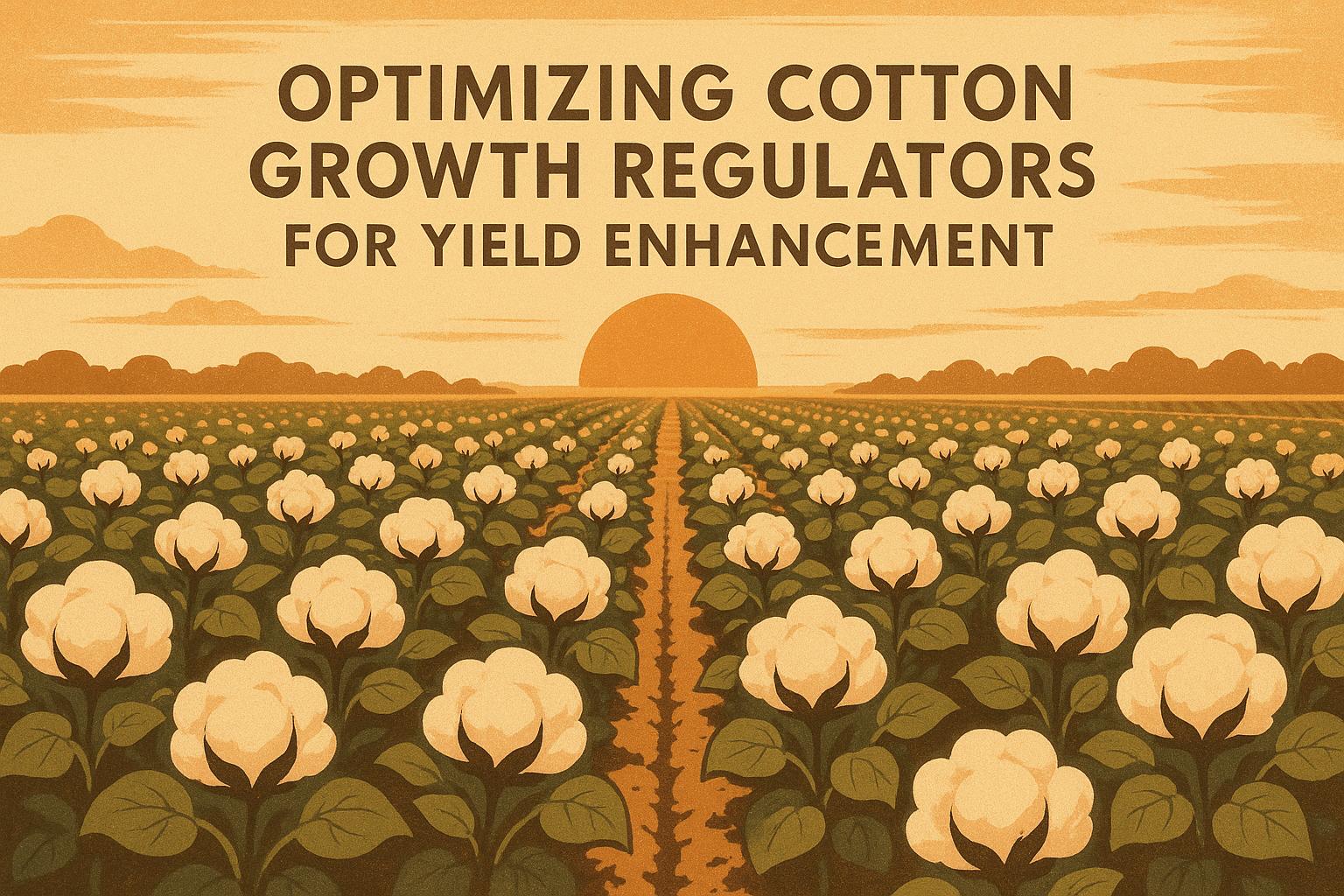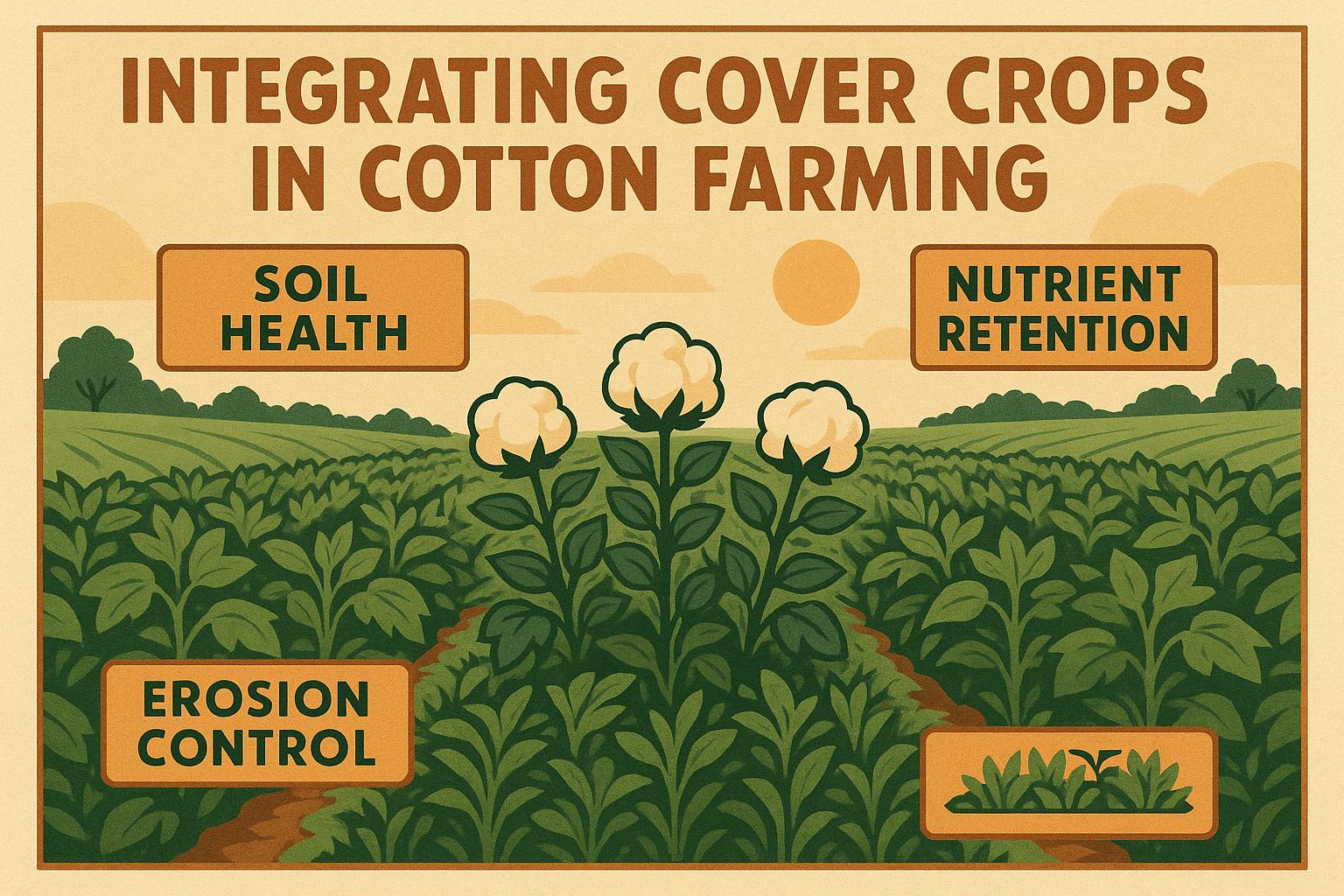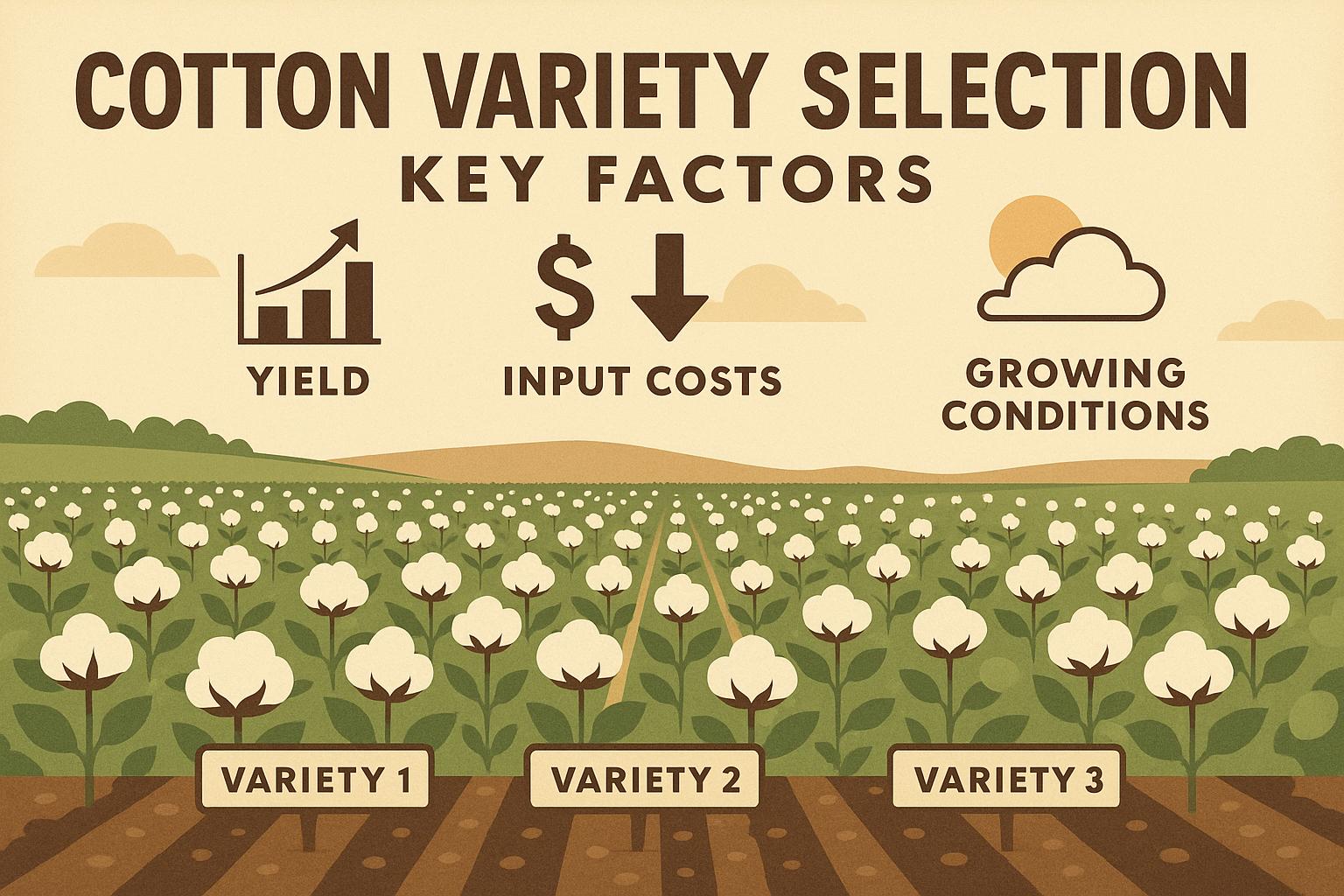Timing your cotton harvest correctly is key to maximizing yield, protecting fiber quality, and ensuring efficient operations. The best way to determine when to harvest isn’t by the calendar - it’s by assessing boll opening rates. Here’s what you need to know:
- Boll Opening Rates measure the percentage of open bolls in a cotton field. A rate of 60%-65% open bolls is often the starting point for harvest, while 75%-80% open bolls is ideal for balancing quality and yield.
- Harvesting too early can leave immature bolls behind, while waiting too long increases risks of weather damage and fiber degradation.
- Methods like percent open bolls and Nodes Above Cracked Boll (NACB) help gauge crop maturity. Combining these with visual inspections and moisture testing provides the most accurate results.
- Weather, equipment, and gin schedules also play a role in determining the optimal harvest window.
Effective Timing of Cotton Defoliation
How to Measure Boll Opening Rates
Measuring boll opening rates accurately involves a methodical approach, honed over years by U.S. cotton producers. The goal is to evaluate your crop's readiness for harvest with consistency and precision. Let’s start with the simplest and most widely used method: percent open bolls.
Percent Open Bolls
The percent open bolls method is a straightforward way to gauge harvest readiness. It involves walking through representative sections of your field and counting both opened and unopened bolls in specific sampling zones.
Here’s how to do it:
- Choose 5–10 random spots across the field, avoiding edges or areas that don’t reflect the field’s overall condition.
- At each spot, examine a 4-foot section of row.
- Count all the bolls that have cracked open to reveal white cotton fibers.
- Divide the number of open bolls by the total number of bolls in the section, then multiply by 100 to calculate the percentage.
Most experts suggest starting your harvest when 60% to 65% of the bolls are open, though this can vary depending on your cotton variety and local conditions. Fields with 75% or more open bolls are typically considered ideal for harvest, balancing yield potential and fiber quality. However, delaying beyond 80% open bolls can increase the risk of weather damage and quality loss.
This method is quick, effective, and doesn’t require any special tools, making it a reliable choice for most producers.
Nodes Above Cracked Boll (NACB)
The Nodes Above Cracked Boll (NACB) method takes a slightly different approach by focusing on the plant’s growth structure. Instead of just counting open bolls, this method gives insight into the crop’s maturity and the potential for further boll development.
To measure NACB:
- Find the uppermost cracked boll on the main stem of the plant.
- Count the number of nodes (where leaves attach to the stem) between this cracked boll and the plant's terminal (the top of the plant).
A lower NACB number indicates greater maturity. Generally, an NACB of 4 or fewer nodes signals that the crop is nearing harvest readiness. Higher numbers suggest there are still immature bolls on the plant that may not contribute much to yield. This method is especially helpful when deciding if harvest aids, like defoliants, will be effective. It sheds light on how much energy the plant is still using to develop upper bolls.
By combining NACB measurements with percent open bolls, you can get a more complete picture of crop maturity, ensuring you don’t harvest prematurely while upper bolls are still maturing.
Additional Methods
There are also supplementary techniques that can refine your harvest timing and give added confidence in your decisions.
- Heat Unit Accumulation: Measured as degree days above 60°F (DD60s), this method uses temperature data to estimate boll maturity. Most cotton varieties need between 850 to 950 DD60s from planting to reach harvest maturity. While this method is great for planning, it should complement, not replace, field observations.
- Visual Inspection: This involves checking individual bolls for fiber and seed development. Mature bolls will have brown or black seeds with fibers that separate easily. Immature bolls will show green or light-colored seeds with fibers that cling tightly.
- Moisture Content Testing: Mature cotton typically has seed moisture content below 10%, while immature cotton often exceeds 12%. Handheld moisture meters can measure this, but they require extra equipment and time.
The best results often come from combining methods. Use percent open bolls as your starting point, support it with NACB counts, and round out your assessment with visual inspections or moisture testing. This multi-method approach ensures you make informed decisions for optimal harvest timing.
How Boll Opening Rates Affect Harvest Timing
As we dive deeper into harvest strategies, it's clear that boll opening rates play a significant role in determining the right timing. Getting the timing right isn't just about pulling in the biggest yield - it’s also about protecting fiber quality and ensuring smooth operations. Harvest timing directly impacts profitability by influencing yield potential, fiber condition, and how efficiently the harvest process unfolds. Plus, timing decisions can help reduce risks tied to unpredictable weather.
Early vs. Late Harvest
When boll opening rates are low, harvesting early can safeguard fiber quality and reduce the risk of weather damage. However, it comes with the drawback of potentially leaving some bolls behind, unharvested. On the other hand, waiting for more bolls to mature increases yield potential but also exposes the crop to weather conditions that could harm fiber quality. Striking the right balance is key to achieving the best results. The table below outlines the pros and cons of early versus late harvests.
Comparison Table: Key Factors
| Factor | Early Harvest (Lower Open Boll Rates) | Late Harvest (Higher Open Boll Rates) |
|---|---|---|
| Yield Potential | Some bolls may remain unharvested | Maximizes yield by allowing full boll maturity |
| Fiber Quality | Protects fiber strength and clarity | Higher risk of weather-related fiber degradation |
| Weather Risk | Minimizes exposure to adverse weather | Increased exposure to weather, potentially delaying harvest |
| Harvest Efficiency | Provides a longer, less rushed harvest window | Requires quicker action once conditions are favorable |
| Regrowth Concerns | Low risk of vegetative regrowth | Higher likelihood of regrowth with extended exposure |
Other factors, such as market conditions and regional weather patterns, also come into play. Timing can affect how quickly cotton can be delivered to gins and processed. Additionally, geographic differences and the specific cotton variety being grown can influence the ideal harvest window. To develop the best harvest strategy, producers need to weigh risks, equipment and labor availability, and local weather trends.
Practical Considerations for U.S. Cotton Producers
When it comes to cotton production, efficient field management is just as important as assessing boll opening and harvest timing. A well-thought-out approach can make all the difference in ensuring a successful harvest.
Equipment and Field Logistics
The type of harvesting equipment you use and how your fields are laid out can significantly impact how effectively you can meet boll opening goals. Some harvesting systems are designed to pick only mature bolls, while others collect everything. Larger, more contiguous fields also streamline operations, making it easier to align boll opening targets with practical fieldwork. This setup not only improves harvesting efficiency but also smooths the process of coordinating with gins.
Planning Around Gin Schedules
Timing your harvest to align with local gin schedules is crucial for maintaining cotton quality and achieving the best market value. During peak harvest times, gin capacity can be stretched thin, leading to delays. These delays can result in quality degradation, especially if cotton has high moisture levels. To avoid this, communicate with your local gin before the harvest begins to secure a processing window. For help locating gins in your area, cottongins.org provides a detailed directory of cotton gin locations across the U.S., making it easier to plan ahead. Efficient gin coordination ensures that the quality benefits of precise boll opening assessments are fully realized.
Weather and Other Timing Factors
Weather is always a wild card in cotton harvesting. Heavy rain or sudden temperature drops can increase moisture levels and damage fiber quality. To protect your crop, adjust your harvest schedule to avoid environmental risks. The goal should be to transfer cotton to the gin before weather conditions can cause quality loss. A flexible harvest plan is essential for preserving both fiber integrity and market value, ensuring your hard work pays off in the end.
sbb-itb-0e617ca
Best Practices for Harvest Timing
Nailing the timing of your cotton harvest involves more than just watching how many bolls have opened. The most successful growers rely on a mix of evaluation methods and field expertise to make decisions that boost both yield and fiber quality. By building on earlier measurement techniques, these best practices help fine-tune the timing of harvests to ensure optimal results.
Ideal Percent Open Bolls
In the U.S., a 60% open boll rate - aligned with a 4 NACB (Nodes Above Cracked Boll) threshold - is often used as a key marker for applying harvest aids. At this stage, most bolls have reached physiological maturity, allowing fibers to fully develop their length and strength.
That said, the 60% benchmark isn’t set in stone. Environmental factors can influence the ideal threshold, and growers should adapt based on local climate conditions and field variability to maintain fiber quality. Flexibility is key when aligning harvest aid applications with real-world conditions.
Adjusting for Unusual Seasons
Weather extremes or unexpected growing conditions often call for adjustments to harvest timing. For instance, prolonged wet periods or sudden cold snaps may require delaying the harvest to allow further fiber development. On the flip side, during drought conditions, bolls might open prematurely. In such cases, early morning field checks can help pinpoint the right time for treatment, minimizing quality losses.
When temperatures dip below 60°F, defoliants become less effective, as cotton plants may stay in a vegetative state longer than expected. Waiting for a warm spell might be the best course of action, even if it means treating when a slightly higher percentage of bolls are open. For growers in weather-sensitive areas, keeping an eye on forecasts and adjusting plans accordingly ensures that harvest timing remains on track, even in challenging seasons.
Using Multiple Assessment Methods
Relying on just one method to gauge harvest readiness can lead to costly errors. While the 60% open boll benchmark is a useful guide, field variability often demands a more nuanced approach.
Research highlights the importance of combining different evaluation methods for a well-rounded assessment:
"Therefore, it is recommended to use a combination of the two methods to accurately determine crop condition."
Factors like environmental stress, insect damage, or varietal differences can create "fruiting gaps", where multiple nodes in a row show aborted fruit. In such cases, relying solely on NACB counts might falsely indicate that the crop is ready, even though many bolls are still immature. Similarly, percent open boll counts can be misleading in fields with uneven maturity or premature boll opening caused by stress.
"When determining maturity, avoid relying on a single method."
- Murilo Maeda, Extension Specialist – Cotton, Texas A&M AgriLife Extension Service
The best strategy is to cross-check multiple indicators, including percent open bolls, NACB counts, and visual fiber assessments. Examining different areas of the field ensures that decisions reflect the crop’s overall condition, reducing the risk of errors and maximizing harvest efficiency.
Conclusion
Timing your harvest to align boll opening rates with operational plans can make a huge difference in both yield and fiber quality. The gap between a well-timed harvest and one that’s rushed or delayed often becomes clear in your yield numbers and the quality premiums you earn at the gin.
Starting with a 60% open boll rate is a solid baseline, but it’s not a one-size-fits-all solution. Factors like weather conditions, field status, and the cotton variety you’re growing all play a role in determining the perfect harvest window. Flexibility is key - sticking rigidly to a single metric can lead to missed opportunities. Using this benchmark alongside other evaluations strengthens your overall strategy.
For the best results, combine different assessment methods rather than relying on just one. Pairing percent open boll counts with NACB measurements gives you a more complete view of crop maturity across the field. This dual approach helps prevent costly mistakes, like harvesting too early in some areas while others still need more time to mature.
Coordinating your harvest with gin schedules and logistical plans ensures you maintain fiber quality and market value. With gins running tight schedules during the harvest season, tools like cottongins.org can help you sync your timing with local facilities. And don’t underestimate the importance of adapting your plans to unexpected weather changes.
When temperatures dip below 60°F or rain disrupts your schedule, having a backup plan is essential. Growers who consistently achieve the best outcomes are those who adjust their methods to fit current conditions, not the ones they hoped for.
Mastering the art of boll opening rates and harvest timing takes experience, observation, and a willingness to adapt. Each season teaches valuable lessons, sharpening your decisions for the future.
FAQs
How do boll opening rates affect the timing of harvest aid applications in cotton farming?
Boll opening rates are a key factor in deciding when to apply harvest aids in cotton farming. The sweet spot? When about 60-65% of the bolls are open. Hitting this timing ensures better defoliation and boll opening, which leads to a smoother harvest and reduces the risk of losing valuable crops.
To get the timing just right, growers can keep an eye on boll maturity signals, like the color of the seed coat or counting the nodes above the first cracked boll. Properly timed applications not only make harvesting more efficient but also help preserve the quality of the cotton crop.
What are the risks of using only one method to decide when to harvest cotton?
The Risks of Relying on a Single Harvest Method
Depending on just one method to decide when cotton is ready for harvest can lead to a host of problems. For starters, it raises the chance of overlooking critical signs that indicate the ideal harvest time. This could hurt fiber quality and reduce overall yields. The timing of boll openings, weather conditions, and the health of the crop all need to be considered to pinpoint the best harvest window.
Sticking to one approach can also create inefficiencies and even safety hazards. For example, ignoring factors like shifting weather or field conditions might result in delays, equipment breakdowns, or financial setbacks. By using multiple methods to assess readiness, farmers can achieve a more precise and effective harvest while avoiding unnecessary risks.
How do weather conditions affect the use of defoliants and the timing of cotton harvests?
Weather significantly impacts how well defoliants perform and how quickly cotton can be harvested. Conditions like temperature, humidity, and sunlight directly affect how the plant responds to defoliants by influencing its physiological readiness for the process.
To achieve the best outcomes, defoliants should be applied during favorable weather conditions, such as warm temperatures with plenty of sunlight. On the other hand, unfavorable weather - like cold snaps or heavy rain - can slow down the process, making harvesting less efficient. This can lead to higher costs and may even compromise the quality of the crop.


